Have you ever stumbled upon a word that sounds like it belongs in a sci-fi novel yet holds profound meaning in our everyday lives? Enter “jätnek.” This term may be baffling at first, but it’s a treasure trove of insights into environmental practices and sustainability. Grab your eco-friendly snacks and a cup of coffee: you’re about to jump into the intriguing realm of jätnek.
jätnek

Jätnek is a concept deeply rooted in waste management and sustainability. At its core, jätnek encompasses organic materials that can be recycled or composted, transforming refuse into valuable resources.
Origins and Historical Context
Historically, the roots of jätnek trace back to ancient practices where communities sought to reuse and recycle materials out of necessity. Ancient civilizations often found themselves surrounded by organic waste. It was this situation that spurred early innovation around composting and reuse. Now, in contemporary society, jätnek holds a vital place in our environmental strategy, marrying historical wisdom with modern needs.
Cultural Significance of Jätnek
The cultural significance of jätnek stretches far beyond waste management: it embodies an ethos of responsibility towards the planet. In many societies, particularly those with strong agricultural traditions, the concept of recycling and composting organic waste has been integrated into their cultural practices.
By promoting the idea of jätnek, these cultures advocate for sustainability, leading to healthier ecosystems and richer soil. This cultural lens can help reshape attitudes towards waste, encouraging individuals to see the value in what might otherwise be discarded.
Contemporary Uses and Applications
In today’s fast-paced world, the applications of jätnek resonate across various sectors. Businesses are increasingly recognizing the environmental impact of their waste.
Environmental Impact and Sustainability
From reducing landfill waste to promoting composting initiatives, the contemporary interpretation of jätnek emphasizes its role in environmental sustainability. Innovations, such as bio-based plastics and renewable energy from organic waste, highlight how häntek technologies can transform waste into resources. Notably, large corporations are adopting jätnek practices, propelling the movement into mainstream awareness and inspiring individuals to join the cause.
Innovative Practices in Jätnek Management
As the world leans into sustainability, innovative practices in jätnek management are emerging. Communities and businesses are developing comprehensive recycling programs and educational initiatives to engage citizens.
Challenges and Future Directions
But, challenges remain. There’s often a gap in public awareness and understanding of jätnek. Bridging this gap is essential for expanding its positive impact. By fostering collaboration between governments, private sectors, and local communities, the future of jätnek can be bright. Investing in technologies that simplify waste sorting and improving compost infrastructure are just a few steps toward a regenerative future.
